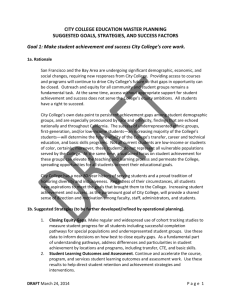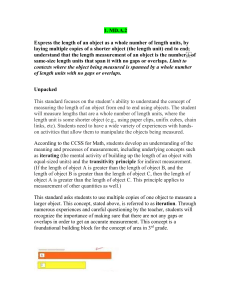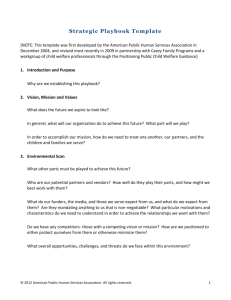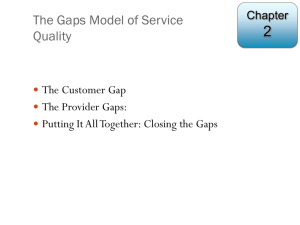Equity, Inclusion and Opportunity
advertisement
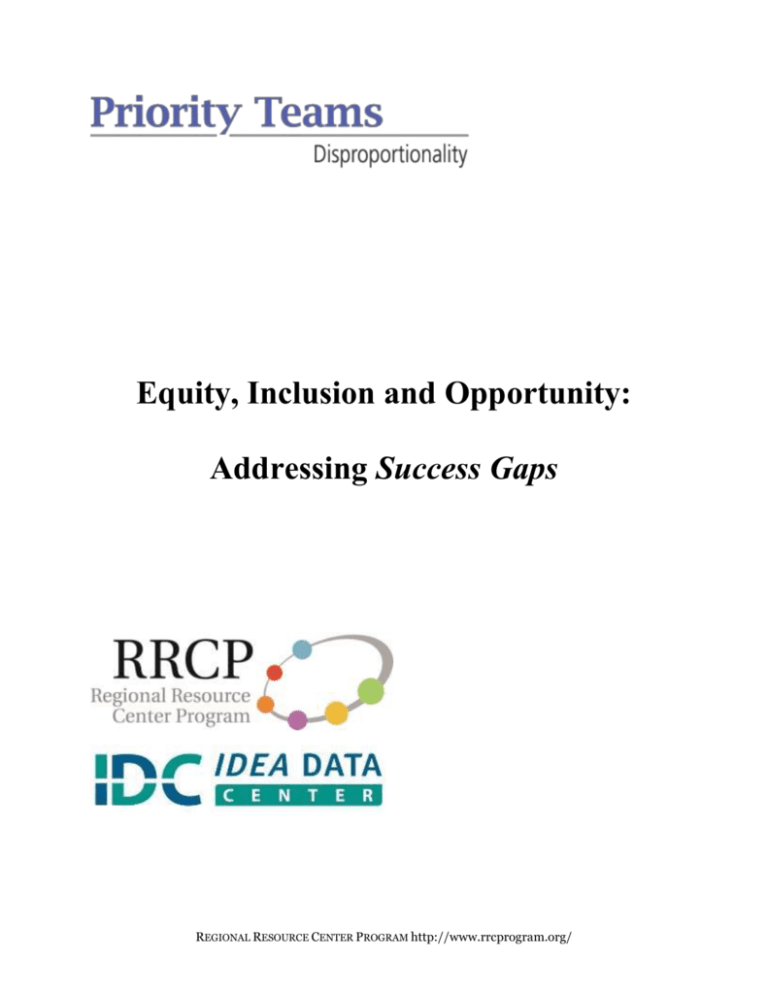
Equity, Inclusion and Opportunity: Addressing Success Gaps REGIONAL RESOURCE CENTER PROGRAM http://www.rrcprogram.org/ Equity, Inclusion and Opportunity: Addressing Success Gaps As an educational leader in your school or district, you may be struggling to address the diverse instructional and/or behavioral needs of your students so that each and every child can achieve to high standards. Some of your students may not be succeeding as well as others or their progress may be slower than expected. Perhaps you have problems like these: “The slow improvement of our English learners is impacting our Adequate Yearly Progress status.” “Our state has designated my school a focus school under its Elementary and Secondary Education Act waiver because of the gap in graduations rates between our economically disadvantaged students and their peers.” “Our state department of special education has identified my district as one that has disproportionate representation of black students in the ‘emotional disturbance’ category.” “The State says we have a significant disproportionality in our suspension rates. Hispanic special education students are being suspended more than students of the other racial/ethnic groups.” “ Our district need to implement strategies to improve the 3rd grade reading proficiency of minority students” “Nobody has labeled our school, but I know that we could get more of our Native American students into upper-level courses.” Equity, Inclusion and Opportunity: Addressing Success Gaps, April 15, 2014 Page 2 of 22 Any of these factors may represent a difference or gap in educational outcomes among particular groups of students. If it was just about academic test scores, we would call it an achievement gap, but test scores are just one part of the story. More importantly, we see these as success gaps (i.e., differences or gaps in a variety of educational factors and outcomes that affect the likelihood of educational success for some groups of students compared to their peers). When such gaps are allowed to continue over time, they lead to poor long term outcomes for entire groups of students, although not for every student, as any group has exceptional individuals. But when your school or district shows success gaps, it means that it is not serving all groups of students equally well. Addressing your school or district’s success gap(s) requires a close look at issues of equity, inclusion, and opportunity. This examination is important across all groups of students throughout your school or district, especially those groups that are struggling academically or behaviorally. Research Research indicates that the achievement of students with disabilities and that of their general education peers is tightly linked (Hehir, Grindal, & Eidelman, 2012; Malmgren, McLaughlin, & Nolet, 2005). In schools where the general education population is successful, students with disabilities are also more likely to do well. All students can benefit from evidencebased instructional practices. We must ensure that students are not placed inappropriately in categories that limit their growth. If they are identified as special education students or English learners, they should have the maximum appropriate opportunity to benefit from evidence-based core content instruction within the general education setting. Equity, Inclusion and Opportunity: Addressing Success Gaps, April 15, 2014 Page 3 of 22 Students who are members of racial, ethnic, or linguistic minorities have barriers and challenges they face in the educational system. Often, when those challenges or barriers are not effectively or efficiently addressed, students may be identified as eligible for English learner or special education services, when the real problem might be with the educational system rather than the unique learning challenges of an individual student. Disproportionate identification by race/ethnicity in special education is a long-standing problem across the United States (US). For example, black students are consistently 24 to 26% more likely to be identified as eligible for special education services as all other students. Furthermore, they are 2 to 2.5 times as likely to be identified as a student with an intellectual disability as all other students (D’Agord, Munk & O’Hara, 2012; Data Accountability Center, 2013). Inappropriate identification in special education is often addressed through effective school-wide culturally responsive and multi-tiered prevention and intervention practices. The number of English learners in our schools is growing every year. According to the National Center for Education Statistics (2011), in 2009 the number of children ages 5 – 17 who spoke a language other than English in the home was 11.2 million students or 21% of the school age population. And approximately 5% of these children are recognized as having difficulty speaking English. Students who are English learners also experience significantly lower levels of academic achievement when compared to their peers (National Center for Education Statistics, 2011). Purpose This document was developed to assist schools and districts to engage in effective practices. It outlines factors in the general education setting that contribute to equitable success for all students including: a) an equitable and effective general education system that utilizes Equity, Inclusion and Opportunity: Addressing Success Gaps, April 15, 2014 Page 4 of 22 high quality instruction and evidence-based pre-referral interventions; b) an appropriate special education referral, identification, and eligibility determination process; and c) access to the general education curriculum and instruction in the least restrictive environment that is appropriate to meet their needs. In addition, the associated rubric (Success Gaps Rubric) that accompanies this document may be used as a tool to assess your own system in relation to these effective practices. The rubric can be used as a starting point for the development of an action plan that will result in changes in practice leading to positive outcomes for all students. Some of the Reasons You Might Need to Review Success Gaps Did Not Demonstrate Annual Yearly Progress (AYP) or Meet Other Accountability Standards Under the ESEA (1965), as amended by the No Child Left Behind Act (NCLB) (2001), all schools and districts are expected to demonstrate AYP each year for each of a set of subgroups. If your state has an approved ESEA flexibility waiver (USDOE, 2012), you may have been identified because a particular group of students did not meet the annual measurable objective (AMO) that your state defined. If you are one of these schools or districts, this document will help you understand and recognize some of the root causes that may be contributing to this under-performance and provide you with data that will inform processes necessary for making improvements. ESEA Focus or Priority Schools The majority of states now have USDOE approved flexibility waivers for many provisions of the ESEA (USDOE 2012), but that does not mean that large achievement or success gaps for subgroups of students are now acceptable. States with ESEA waivers must identify schools that fall into the categories of focus schools or priority schools. Priority schools Equity, Inclusion and Opportunity: Addressing Success Gaps, April 15, 2014 Page 5 of 22 are the lowest 5% of Title I schools within the state, and focus schools have the largest withinschool gaps in achievement or graduation or have low achieving subgroups. Once identified, these schools are required to address the poor performance of their students. If you represent a focus or priority school, this document will help you identify the potential causes of these gaps and develop strategies to address them. Disproportionate Representation If your school district has been identified as having disproportionate representation in special education for specific groups of students, your state education agency (SEA) is required by the Individuals with Disabilities Education Act (IDEA)(2004) regulations to determine if that disproportionate representation is the result of inappropriate identification of students with disabilities. Effective approaches to determining inappropriate identification consider a wide range of factors or practices that could contribute to students being inappropriately referred for special education services or inaccurately identified as having a disability. The factors investigated should include violations of IDEA (2004) statutory or regulatory provisions (e.g., eligibility determination) and procedures such as state eligibility guidelines. They should also include a review of practices in general education, such as the quality of literacy instruction, the availability of multi-tiered interventions for struggling learners, and/or the school-wide implementation of positive behavior supports. This document and the Success Gaps rubric will help you assess your own school or district to determine if disproportionate representation is the result of ineffective general education instructional practices or inappropriate identification procedures and, if so, what you can do to address the problem. Equity, Inclusion and Opportunity: Addressing Success Gaps, April 15, 2014 Page 6 of 22 Significant Disproportionality When a local school district has been identified by its state department of special education as having significant disproportionality for a particular racial or ethnic group based on special education identification, disability category, placement or discipline, that district is required to allocate 15% of its federal special education funds to provide coordinated early intervening services (CEIS)(IDEA, 2004). CEIS supports struggling students who are not receiving special education services. The goal is to prevent the need for special education services and inappropriately identified students. If you are one a school in one of these districts, this document and its associated rubric will help you to effectively provide targeted early intervening services to address factors that contribute to significant disproportionality. By providing effective early intervening practices through general education, student outcomes will improve and inequities in identification, placement or disciplinary actions by race/ethnicity can be mitigated. Overall School Improvement: Improving Results for All Students Perhaps your interest in this document stems from the desire to ensure that all children receive an equitable education and that all children in your school have the same opportunity to graduate from high school, college and/or career ready. All schools are encouraged to take a proactive approach to school improvement, recognizing that a focus on cross-group equity is often the very best way to create a world-class school. This document and the Success Gaps rubric will help you identify evidence-based practices that will support you in making the changes necessary to ensure equity for all students. Equity, Inclusion and Opportunity: Addressing Success Gaps, April 15, 2014 Page 7 of 22 Factors That Contribute to Success for All Students Research has identified a number of factors that contribute to success for all students. These include a) data-based decision making, b) cultural responsiveness, c) a high-quality core instructional program, d) ongoing assessment including student screening and progress monitoring, and e) evidence-based interventions and supports to meet students’ needs. In delivering instruction at all levels, particular attention should be given to fidelity of implementation, with consideration for cultural and linguistic responsiveness and recognition of student strengths (See The National Center on Response to Intervention, http://www. rti4success.org/). This list and the Success Gaps rubric clearly define the factors cited by research as necessary for closing success gaps and ensuring that all students have an equitable opportunity to graduate from high school, college and/or career ready. Data-Based Decision Making (Hamilton, Halverson, Jackson, Mandinach, Supovitz, & Wayman, 2009; Hosp, Hosp, & Dole, 2011; McDonald, Andal, Brown, & Schneider, 2007) 1. Decisions about the school curriculum, instructional programs, academic and behavioral supports, and school improvement initiatives are based on data that are disaggregated for the school reflecting the differences in subgroups by gender, race/ethnicity, socioeconomic factors, disability, and native or home language. For example, data on graduation, attendance, drop out, discipline, and achievement are all examined and considered individually and collectively. Equity, Inclusion and Opportunity: Addressing Success Gaps, April 15, 2014 Page 8 of 22 2. Decisions about student interventions (behavioral and/or academic) are made based on multiple data sources including screening, progress monitoring and formative and summative assessment data. Cultural Responsiveness (Henderson & Mapp, 2002; Klingner et al., 2005) 1. Effective academic and behavioral practices for all learners are based on a school’s recognition of diversity across student ethnicity, language and socio-economic status. 2. Training and resources are provided and designed so teachers can meet the linguistic needs of all students including students with disabilities that are also English learners. 3. Parents from all backgrounds are included in discussions/meetings about the school, the school programs or initiatives and their children’s academic and behavioral progress. Core Instructional Program (Huberman, Navo and Parrish, 2012; Jorgensen, McSheehan and Sonnenmeier, 2009; Newmann, Smith, Allensworth, & Bryk, 2001; Tomlinson et al., 2003; Waterman & Harry, 2008) 1. There is a rigorous, consistent and well-articulated K-12 instructional program (i.e., curriculum and instructional delivery) that is aligned with both English language arts and mathematics standards, and delivered with fidelity. 2. Effective differentiation in the core curriculum addresses the needs of the full range of learners, learning styles, and cultural and linguistic backgrounds. 3. Universal design for learning guidelines are an integral component of the instruction. Equity, Inclusion and Opportunity: Addressing Success Gaps, April 15, 2014 Page 9 of 22 4. Parents are informed, in their native or home language, about the differentiation of instruction and assessment data based on their child’s unique learning or behavioral needs. Assessment-Universal Screening and Progress Monitoring (Fuchs & Fuchs, 2002; Huberman, Navo and Parrish, 2012; Jorgensen, McSheehan and Sonnenmeier, 2009) 1. All students are screened for early identification of academic or behavioral risk factors using valid and reliable tools. 2. All student progress is monitored to make needed adjustments to instruction and/or interventions. Valid and reliable progress monitoring tools are identified and available at each school, with reasonable intervals for monitoring defined and implemented, performance data reviewed at regular intervals, and instruction/interventions adjusted based on data review cycles. 3. Parents and guardians are regularly informed in their native or home language, of their child’s screening and progress monitoring results for academic or behavioral progress. Evidence-Based Instructional and Behavioral Interventions and Supports (Advancement Project, 20131; Advancement Project, 20132; Benner, Beaudoin, Chen, Davis, & Ralston, 2010; Griffiths, Parson, Burns, VanDerHeyden, & Tilly, 2007; Dignity in Schools Campaign, 2012; King-Brown, Trone, Fratello, Dafurty-Kapur, 2013; & Lassen, Steele, & Sailor, 2006; National School Boards Association, 2013; U.S. Department of Education, 2014) 1. Evidence-based interventions and behavioral supports are embedded within a multitiered framework and implemented with fidelity. Equity, Inclusion and Opportunity: Addressing Success Gaps, April 15, 2014 Page 10 of 22 2. School level practices employ evidence-based behavioral interventions and tiered response methods such as positive behavioral interventions and supports, restorative practices, etc. 3. District level discipline policies that utilize tiered response protocols as opposed to zero tolerance policies. 4. Parents and guardians are regularly informed, in their native or home language, of interventions provided to their children and their children’s responses to those interventions for academic and behavioral skills. Factors That Contribute to Appropriate Identification for Special Education Services Special education provides specialized instruction and related services to eligible students with disabilities. These services enable them to access the general education curriculum and make progress on the standards that allow them to progress from grade to grade in order to graduate being college and/or career ready. Generally, students are only identified as having a disability when a pre-existing condition exists as identified in the IDEA and the child needs special education services, or there is evidence that general education, even with interventions and supports, is not able to provide an appropriate academic or behavioral program. It is not allowable to identify a child as having a disability and eligible for special education when that disability is due to a lack of appropriate instruction in general education reading and/or math. In addition, identification of a student for special education services is only considered after a Equity, Inclusion and Opportunity: Addressing Success Gaps, April 15, 2014 Page 11 of 22 number of factors in general education have been addressed. These include the factors contributing to success for all students and listed in the previous section, above. Only when these conditions have been addressed and the student continues to have difficulties is it appropriate to consider the student’s eligibility for special education services. In the process of identifying a student for special education services, all federal regulations for an individual student evaluation must be followed. Once identified, individual students must receive effective, scientifically-based instruction and practices from both general and special educators. The goal is continuous academic or behavioral improvement allowing the student to make progress in the general education standards-aligned curriculum. Some students who receive special education may demonstrate sufficient progress and self-management skills so that an evaluation team may determine that the student no longer requires specially designed academic instruction in order to continue to make progress. Appropriate identification is tied to policies, procedures, or practices which are addressed only after general education pre-referral intervention practices have been implemented. These policies, procedures and practices are used during the special education referral, evaluation, and eligibility process. There must be an analysis of the educational services that the student has received prior to referral and a determination that the success gaps for the individual student are not a result of a lack of appropriate instruction. The list below and the Success Gaps rubric describe an appropriate identification process in terms of a) referral, b) evaluation, and c) eligibility. Referral: 1. Student referrals are accompanied by documentation of scientific, research or evidence-based academic and/or behavioral interventions used prior to referral. Equity, Inclusion and Opportunity: Addressing Success Gaps, April 15, 2014 Page 12 of 22 2. Functional and developmental information for referred students is collected to inform that referral process (e.g., health history, school history, language proficiency). Evaluation: 1. A comprehensive evaluation process examines all suspected areas of disability including, as appropriate, health, vision, hearing, social and emotional status, general intelligence, academic performance, prior instruction, communicative status and motor abilities. 2. The placement team avoids biased decision-making. For example: professional or personal biases on the part of the placement team are kept in check. 3. Multiple measures are used to determine if the student has a disability. The assessments target suspected disabilities. Non-discriminatory evaluation instruments, unbiased by the child’s cultural and linguistic background, are used. 4. Materials and procedures used to assess a student with limited English proficiency are selected and administered to ensure that they measure the extent to which the student has a disability rather than limited English skills that contribute to poor academic performance. 5. Evaluations are provided and administered in the language most likely to yield accurate information on what the child knows and is able to demonstrate academically, developmentally and functionally. 6. Technically sound instruments that can assess the relative contribution of cognitive and behavioral factors, in addition to physical and developmental factors are used. Equity, Inclusion and Opportunity: Addressing Success Gaps, April 15, 2014 Page 13 of 22 Eligibility: 1. Eligibility decisions are made by a team of appropriate, qualified professionals with meaningful parent involvement in the evaluation process. 2. Students are evaluated and, when the criteria for having a disability and need for specialized instruction are met, they are recommended for special education services by a properly staffed student support team using an evidence-based decision-making process. 3. Progress is monitored to review the continuing needs for special education supports and services, and reevaluation is conducted as needed. Provision of Special Education Services If a student is identified as having a disability and in need of specialized instruction, then the special education services and the provision of classroom accommodations and instructional modifications and supports, are designed and implemented jointly by the student’s general and special education teachers. A student’s eligibility for special education services does not remove responsibility or accountability from general educators for the instruction and academic progress of that student. Students with disabilities are general education students first and are assessed using the same measures as their general education peers, except for a small percentage (approximately one percent) of the special education population that has significant cognitive impairments. Receiving special education services does not mean that a lower standard can be applied, or that the full responsibility for ensuring access to and progress in the general education curriculum is placed solely upon special education personnel. Research continues to point out that inclusive practices which include the provision of special education services within the Equity, Inclusion and Opportunity: Addressing Success Gaps, April 15, 2014 Page 14 of 22 context of the general education classroom through collaborative service delivery, provide the most positive outcome for students with disabilities (Hehir, Grindal, & Eidelman, 2012). Access to special education services within the least restrictive environment of the general education classroom must be the first consideration when making decisions on how to provide the most equitable educational opportunities for students with disabilities. Inclusive collaborative special education services that reduce success gaps include: 1. Consultative special education supports - Student receives instruction in the general education classroom with indirect support from the special education teacher in order to most effectively use accommodations and assistive technology. 2. Collaborative special education supports- Student receives core instruction in the general education classroom, but may receive some direct instruction from the special educator as needed through supplemental or other direct instruction as well as support with materials and strategy instruction. 3. Co-teaching special education supports- Special educator and general educator work together in the same classroom to deliver instruction to a blended group of students. 4. Supplemental special education supports- Students receive core content instruction within the general education classroom, and receive additional supplemental support from the special education teacher either in the general education classroom or special education setting 5. Intensive special education supports- Students receive intensive intervention instruction from the special education teacher in a core subject area in the special education setting. Students participate in general education classroom instruction, only being removed when supplementary aids and services cannot be appropriately delivered Equity, Inclusion and Opportunity: Addressing Success Gaps, April 15, 2014 Page 15 of 22 in the general education setting, and thus ensuring the provision of the least restrictive environment. Moving Forward—Recognizing the Need for Change The first step toward ensuring equity, inclusion and opportunity for all students is to recognize the need for change in your school or district’s current practices and policies because you have identified a group of students who are experiencing success gaps. The second step is to identify the root causes of the problem. The third step is to make the changes that address those root causes. As a companion to this document, you will find a two-part rubric that will help you in step two, to identify the root cause(s). We suggest the following process for using the rubric to assess conditions in your school or district: 1. Form a Team: Identify a team of general educators, special educators, administrators, parents and, in the upper grades, students who are willing to make a commitment to this self-assessment process. Be sure this team includes: Parents (and, in the upper grades, students) representing the group that is of concern in your school or district; Special education and general education professionals who work with the target group; Special education and general education professionals who work with the students who are succeeding; Professional support staff such as school psychologists, school counselors and others who may provide support to students who are struggling; and Leaders with the authority to make the necessary changes. Equity, Inclusion and Opportunity: Addressing Success Gaps, April 15, 2014 Page 16 of 22 2. Study the Data: As a team, study the relevant data prior to attempting to complete the rubric. Data should be both aggregated and disaggregated and reviewed for the identified reason for self-assessment. In addition, the team may want to expand the data they are reviewing to determine how other results such as graduation, drop out, achievement, disciplinary practices and attendance are related to the identified success gap. 3. Conduct Self-Assessment: As a team, study the rubric; then answer each question with complete frankness and honesty. 4. Provide Evidence: Be sure that you carefully document the data supporting your answers. 5. Consider the Students First: Always keep in the mind the experiences of the group of students for whom there is a success gap in your school or district. 6. Ensure Equitable Participation: Be sure that all team members’ voices are heard and respected. 7. Develop a Plan of Action: Develop an actionable plan to address the root causes you have identified. Be sure that it is integrated with your school or district’s other improvement activities. Using the self-assessment will lead you to the root causes of your success gaps so that you can develop a practical action plan to address them. As you develop the action plan, think outside the box. “We’ve always done it this way” is never a sufficient justification to continue down an unsuccessful path. For step three of this process, develop a specific, measurable action plan that includes short and long-term benchmarks to address the root cause(s) of your problem. The plan should be integrated into your existing school improvement plan(s). This document intentionally does not Equity, Inclusion and Opportunity: Addressing Success Gaps, April 15, 2014 Page 17 of 22 provide a format for an improvement plan as most schools and districts already have a format they are utilizing. There is likely to be more than one reason that your success gap exists. Teams will have to prioritize the strategies and action steps they will take. To ensure progress on the plan, the development of short term implementation action steps or benchmarks is a way to ensure regular review of your progress. This periodic check will allow the team to make adjustments to the plan based on what is learned from the data. Additionally, routine reviews keep the team informed of progress toward the plan’s expected outcomes and of any changes to team members’ roles and responsibilities within the plan. Equity, inclusion and opportunity for all students is an important goal, but one that is not easily achieved. The systemic factors that contribute to success gaps for particular groups of students are often difficult to identify and to address. As a leader in your school or district, we know you care deeply about all of the children you serve. You are in a position to improve the opportunities and outcomes for those students requiring support. We hope this document will help you recognize and deliver what is needed so that each and every student in your school and district is successful. Equity, Inclusion and Opportunity: Addressing Success Gaps, April 15, 2014 Page 18 of 22 References Advancement Project. (2013). Key components of a model discipline policy: A policy guide for school board members. Retrieved from: http://safequalityschools.org/resources/entry/model-school-discipline-policy; Advancement Project. (2013). Model school discipline policy. Retrieved from: http://safequalityschools.org/resources/entry/model-school-discipline-policy Benner, G. J., Beaudoin, K. M., Chen, P., Davis, C., & Ralston, N. C. (2010). The impact of intensive positive behavioral supports on the behavioral functioning of students with Emotional Disturbance: How much does fidelity matter? Journal of Behavior Assessment and Intervention in Children, 1(1), 85-100. D’Agord, C., Munk, T., & O’Hara, N. (2012). Looking at race/ethnicity disproportionality in special education from the student outcomes side of the educational system: Why analyzing disproportionality matters for results improvement planning. Presentation at 2012 IDEA Leadership Conference, Washington, DC. Downloaded on April 30, 2013 from http://leadership-2012.events.tadnet.org/pages/134. Data Accountability Center. (2003). Data Tables for OSEP State Reported Data. [Table AA15]. Retrieved on August 21, 2013 from https://www.ideadata.org/tables27th/ar_aa15.htm. Dignity in Schools Campaign. (2012). A Model Code on Education & Dignity: Presenting a Human Rights Framework for Schools. Retrieved from: http://www.dignityinschools.org/ourwork/model-school-code Elementary and Secondary Education Act of 1965, Pub.L. No. 89-10, 79 Stat. 27 (1965). Retrieved on August 22, 2013 from http://www.gpo.gov/fdsys/pkg/STATUTE-79/pdf/STATUTE-79Pg27.pdf Equity, Inclusion and Opportunity: Addressing Success Gaps, April 15, 2014 Page 19 of 22 Fuchs, L. S., & Fuchs, D. (2002). What is scientifically-based research on progress monitoring? (Technical report). Washington, DC: National Center on Student Progress Monitoring. Griffiths, A., Parson, L. B., Burns, M. K., VanDerHeyden, A., & Tilly, W. D. (2007). Response to intervention: Research for practice. Alexandria, VA: National Association of State Directors of Special Education, Inc. Hamilton, L., Halverson, R., Jackson, S., Mandinach, E., Supovitz, J., & Wayman, J. (2009). Using student achievement data to support instructional decision making (NCEE 2009-4067). Washington, DC: National Center for Education Evaluation and Regional Assistance, Institute of Education Sciences, U.S. Department of Education. Retrieved from http://ies.ed.gov/ncee/wwc/publications/practiceguides/. Hehir, T., Grindal, T., & Eidelman, H. (2012). Review of special education in the Commonwealth of Massachusetts. Boston, MA: Thomas Hehir and Associates. Henderson, A. T., & Mapp, K. L. (2002). A new wave of evidence: The impact of school, family, and community connections on student achievement (Annual Synthesis 2002). Austin, TX: National Center for Family and Community Connections with Schools. Retrieved on August 22, 2013 from http://www.sedl.org/connections/resources/evidence.pdf. Hosp, J. L., Hosp, M. A., & Dole, J. K. (2011). Potential bias in predictive validity of universal screening measures across disaggregation subgroups. School Psychology Review, 40(1), 108-131. Huberman, M., Navo, M., & Parrish, T. (2012). Effective practices in high performing districts serving students in special education. Journal of Special Education Leadership, 25(2),5971. Individuals with Disabilities Education Act of 2004, Pub. L. No. 108-446, 118 Stat. 2647 (2004). Retrieved on August 22, 2013 from http://www.copyright.gov/legislation/pl108-446.pdf. Equity, Inclusion and Opportunity: Addressing Success Gaps, April 15, 2014 Page 20 of 22 Jorgensen, C.M., McSheehan, M., & Sonnenmeier, R. M. (2009). Essential best practices in inclusive schools, Institute on Disability, University of New Hampshire. King-Brown, J., Trone, J., Fratello, J., & Dafarty-Kapur, T. (December, 2103). A Generation later, what we’ve learned about the zero tolerance in schools. Issue Brief, Center on Youth Justice, Vera Institute of Justice, retrieved from www.vera.org. Klingner, J. K., Artiles, A. J., Kozleski, E., Harry, B., Zion, S., Tate, W., & ... Riley, D. (2005). Addressing the disproportionate representation of culturally and linguistically diverse students in special education through culturally responsive educational systems. Education Policy Analysis Archives, 13(38), 1-42. Lassen, S. R., Steele, M. M., Sailor, W. (2006). The relationship of school-wide positive behavior support to academic achievement in an urban middle school. Psychology in the Schools, 43(6), 701-712. Malmgren, K. W., McLaughlin, M. J., & Nolet, V. (2005). Accounting for the performance of students with disabilities on statewide assessments. The Journal of Special Education, 39(2), pp. 86-96. McDonald, S., Andal, J., Brown, K., & Schneider, B. (2007). Getting the evidence for evidencebased initiatives: How the Midwest states use data systems to improve education processes and outcomes (Issues & Answers Report, REL 2007-No. 016). Washington, DC: U.S. Department of Education, Institute of Education Sciences, National Center for Education Evaluation and Regional Assistance, Regional Educational Laboratory Midwest. Retrieved from http://ies.ed.gov/ncee/edlabs. National Center for Education Statistics (2011). The Condition of Education [Table A-6-2]. Retrieved April 3, 2013 from http://nces.ed.gov/programs/coe/tables/table-lsm-2.asp. National Center on Response to Intervention, http://www.rti4success.org/. Equity, Inclusion and Opportunity: Addressing Success Gaps, April 15, 2014 Page 21 of 22 National School Boards Association. (2013). Addressing the out-of-school suspension crisis: a policy guide for school board members. Retrieved from: http://www.nsba.org/suspensions; No Child Left Behind Act of 2001, Pub.L. 107-110, 115 Stat. 1425 (2002). Retrieved on August 22, 2013 from http://www2.ed.gov/policy/elsec/leg/esea02/index.html. Newmann, F. M., Smith, B. A., Allensworth, E., & Bryk, A. S. (2001). Instructional program coherence: What it is and why it should guide school improvement. Educational Evaluation and Policy Analysis, 23(4), 297-321. Tomlinson, C. A., Brighton, C., Hertberg, H., Callahan, C. M., Moon, T. R., Brimijoin, K., & … Reynolds, T. (2003). Differentiating instruction in response to student readiness, interest, and learning profile in academically diverse classrooms: A review of literature. Journal for the Education of the Gifted, 27(2/3), 119-145. United States Department of Education. (2012). ESEA Flexibility. Retrieved from http://www2.ed.gov/policy/elsec/guid/esea-flexibility/index.html. United States Department of Education. (2014) School discipline guidance package. Retrieved from: http://www2.ed.gov/policy/gen/guid/school-discipline/index.html) Waterman, R., & Harry, B. (2008). Building collaboration between schools and parents of English language learners: Transcending barriers, creating opportunities (Practitioner Brief). Tempe, AZ: National Center for Culturally Responsive Educational Systems. Retrieved from http://www.niusileadscape.org/docs/FINAL_PRODUCTS/LearningCarousel/Building_Colla boration_Between_Schools_and_Parents_of_ELLs.pdf. Equity, Inclusion and Opportunity: Addressing Success Gaps, April 15, 2014 Page 22 of 22
